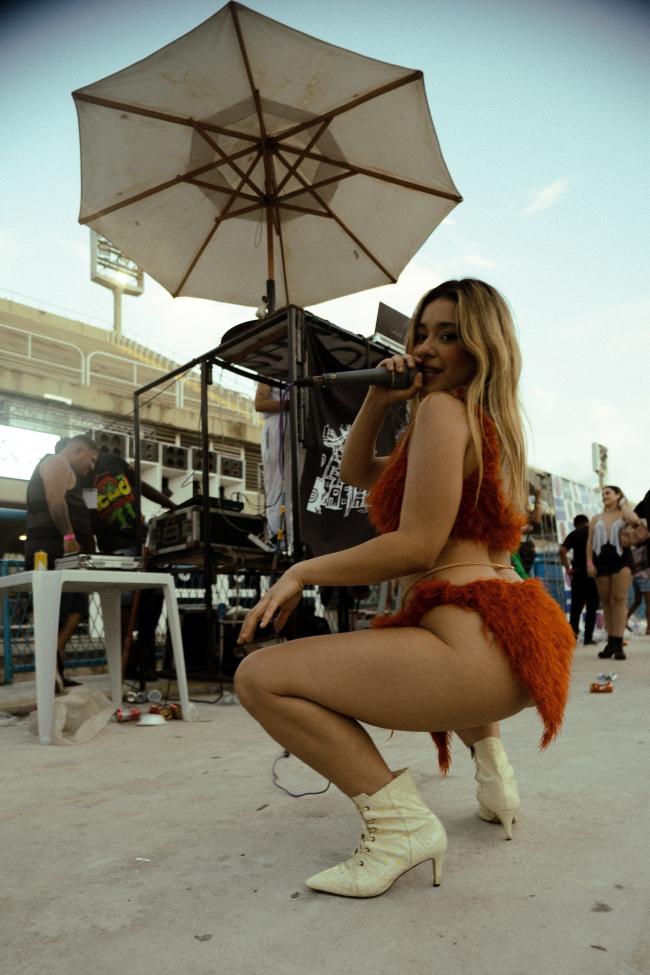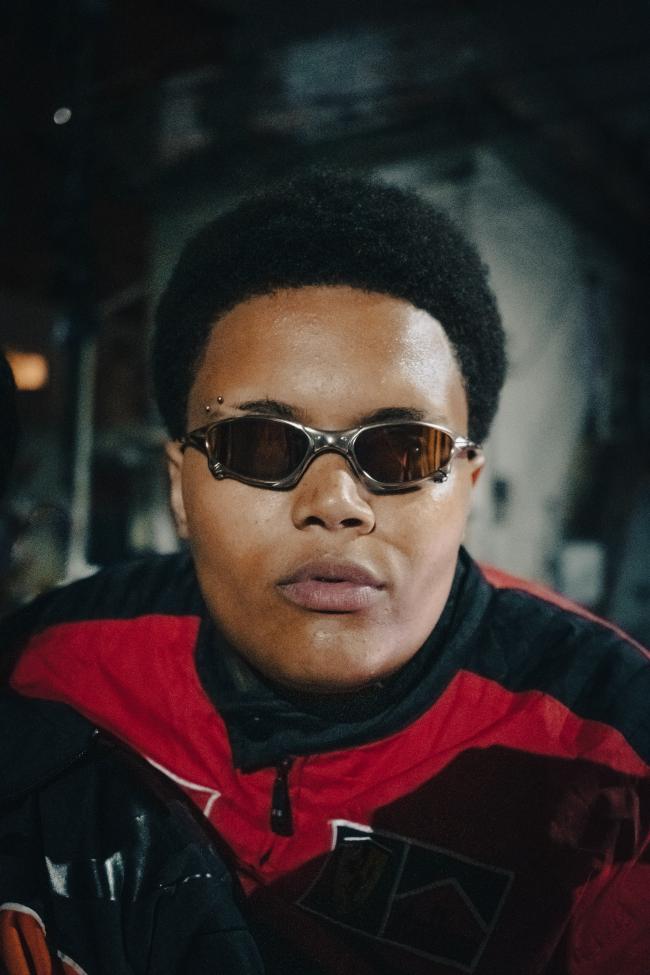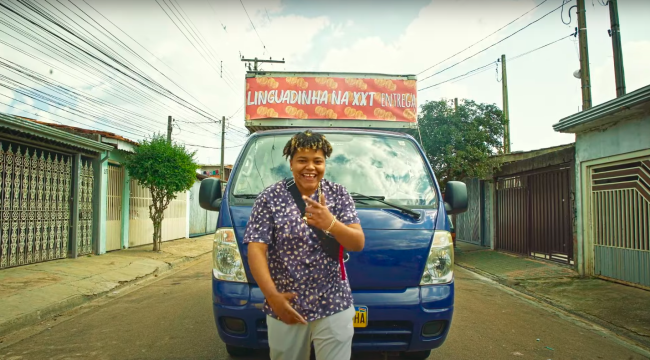
MC Marie answers the interview call in a bikini, reclined at the pool of Férias do Poxa, a new influencer house for bisexual and lesbian Brazilians to collaborate on social media content. MC Marie is a funkeira (woman funk artist) who sings songs full of explicit sexual declarations, such as her hits “Gosto Muito” (“I really like”), released on the Brazilian National Day of Lesbian Visibility in 2021; “To Querendo um App” (“I’m Wanting an App,” about a lesbian sex app”); and “Ele Me Quer, Ela Me Quer,” (“He Wants Me, She Wants Me”), a bisexual anthem written for a friend. The vulgarity is not for nothing; these songs are part of a growing subgenre of Brazilian funk that is pushing for a new kind of liberation through music.
In recent weeks, I spoke with MC Marie, MC Mano Feu, and MC Lalão do TdS, three funkeiras behind the Sapafunk (funk sapatão) subgenre, to get a sense of how these artists see themselves and their music as they raise lesbian visibility in a male-dominated world of funk.
Sapatão, which literally means “big shoe,” comes from “Maria Sapatão,” a nickname first used in the 1970s to refer, derogatively, to queer women said to prefer men’s shoes over “ladylike” shoes. “Sapatão” has since been reclaimed by the community, evidenced by the myriad of graffiti tags and stickers advertising sapphic parties on the bathroom walls of São Paulo’s lesbian bars. Asked to define the term, MC Marie cheekily begins singing the chorus of her song “A Dyke Olhou pra Mim” (“A Dyke Looked at Me”), suggesting “dyke” as the closest English equivalent.
Funk: A Legacy of Protest
Recognizable by its bass-driven volume and hard-hitting lyrics, the broader genre of Funk Carioca or Brazilian Funk originated in Rio de Janeiro in the 1980s, a creation of Brazil’s largely Afro-Brazilian favela communities. Drawing influences from a range of Black music in the United States such as hip-hop, Miami bass, and funk, favela residents invented a genre in their language, along with shades of traditional African religious music, samba, and other regional genres.
MC Marie grew up in Fonsequistão (Fonseca) in the North Zone of Niterói, Rio de Janeiro, before eventually relocating to São Paulo. She began singing lesbian funk when she was living in the Morro do Palácio favela of Niterói, while studying art at the federal university nearby. During that time, she frequently performed for her sapatão friends: “I make music we want to hear, right?”
MC Mano Feu, of the San Martin community of Campinas, São Paulo got her start in poetry and funk consciente (socially conscious funk). Her early songwriting recounted her experiences growing up in her favela.
MC Lalão do TdS, of the Taboão da Serra region of São Paulo, similarly grew up immersed in the genre: “Funk was something that came from my childhood… Funk is more than a musical genre. Being a funk singer is a lifestyle, it’s the way you dress, the way you carry yourself, a visual identity, a body identity, a way of speaking, a way of behaving. It’s who you are. Funk is important because it reinforces my identity—it’s an identity for many people from the periphery.”
Beyond serving as a protest discourse of Brazil’s youth, funk has a rich history as a catalyst for social change, tackling issues such as poverty, racism, and police violence. The politically subversive power of its lyrics also creates a medium for marginalized youth to claim and express their pleasure through sex, love, and joy. In an interview about his recent book O Funk na Batida, Danilo Cymrot asserts that the key to funk’s popularity is that it doesn’t come from the top down. There is a certain made-at-home, grassroots character to the music—both its creation and success. A genre immensely popular across the globe, currently reaching a new level of fandom through its rapid spread on TikTok, funk music remains a vibrant protagonist voice of Brazil’s Black and favela communities.

Social Tensions Surrounding Funk
Funk is also contentious. Cymrot writes about the complexities surrounding the genre’s criminalization. “Arrastão,” or dragnet, referring to a trawler net that drags along the ocean floor, collecting fish and anything else, is a term that, in Brazil, has come to refer to an event of mass theft in a public space. The term first gained traction in 1992 following an episode of mass mob theft on Arpoador Beach in Rio de Janeiro, between Copacabana and Ipanema. Anthropologist Hermano Vianna identifies this event, and the extensive media coverage that followed, as an inflection point. The middle and upper-class residents of Rio’s South Zone became increasingly concerned about what was construed as unruly young people from the periphery, and funk music was seen as their anthem. What followed included both growing fandom—glamorization, even, Cymrot writes—of life in Brazil’s favelas and, simultaneously, attempts by the state to discipline or suppress the famous baile funk parties they were known for.
MC Marie speaks about her earliest memories of funk, when her school hosted a career day. Her mother, who had no formal work at the time, showed up in a skirt, with a little radio in hand, and taught the seven- and eight-year-olds how to dance funk. “Parents started pulling their children out of school because my mother was teaching funk,” Marie says. “There was a big prejudice against funk, a discomfort with this culture that comes from the periphery.”
Sapafunk: A New Wave of Social Change
The critiques of funk music extend beyond those of a racist and classist nature. There is much discussion about funk lyrics’ encouragement of drugs and violence, machismo, objectification of women, and child eroticization. “Novinhas,” slang for young teenage girls, are often the subject of mainstream funk putaria (funk with aggressively sexual lyrics). Although they both speak lovingly about what funk at large means to them, MC Marie and MC Mano Feu also point to the sexism and homophobia that exist within the genre, both in the lyrics and in the industry itself. “Funk reproduces a sexist stereotype of abuse, of domination,” MC Marie says. “Just listen, just pay attention to the lyrics.”
Building on the work of funkeiras such as MC Katia, Ludmilla, Anitta, MC Carol, Tati Quebra Barraco, and Valesca Popozuda, these Sapafunk artists feel compelled to build something new. Collaboration is key in this small and growing genre, including the upcoming release titled “Sapafunk” sung by seven funkeiras: MC Mano Feu, MC Marie, MC Lalão do TdS, MC k-rolzinha, MC L Original, MC Paola, and MC Sapinha. In MC Marie’s words, “It's a place of struggle, it's a place that we are creating. It’s something that seems late, but we have been fighting for a long time and there is no space [for us].” She continues, “We are few, right? So, we help each other a lot.”
Wrapped up in the genre of funk at large, the Sapafunk artists explain, is a total focus on the sexual desires of men. These funkeiras are flipping that on its head—but it doesn’t mean it’s PG-rated. In “A Dyke Olhou pra Mim,” MC Marie sings (translated from Portuguese): “She lay down on the bed, I was already without panties / I sat on her face, until she suffocated / She didn't ask for a break, I screamed I want to give it to you / I looked at a dyke, a dyke looked at me.”
Some may critique the lyrics as crude. But the sexually explicit nature, like that of mainstream funk, is itself of political significance. MC Marie explains: “Even if the song is playful, even if it's fantasy, it's coming from a place of my desire. My music talks about my experience, which is not just mine. But it's a rare thing, this expression of the desires of women who love other women.”
MC Mano Feu elaborates: “I used to have a prejudice towards funk putaria [funk with heavily sexual lyrics], but I deconstructed this. Like, if what's popular right now is talking about sex, I'm going to talk about mine, about what's good for me.” She continues, “The guys are out there spouting a lot of bullshit. Only their pleasure has visibility, mine doesn't. We talk about our pleasure without denigrating or humiliating anyone. Hey, if we're going to talk about sex, let's talk about ours.
She adds: “Oh, and it also has to be a more danceable, happier funk hit.”

This music is an effort for representation, to be sure. MC Marie laments the fact that even at a “rolê sapatão” (sapatão party), people dance to music about straight sex and romance. In MC Mano Feu’s “Sou Sapatão” (I’m a sapatão), contrastingly, she sings: “I’ve already called the most beautiful, hot, chubby girls, who like to dance, the Black girls who get down, who twerk in a way that makes everyone stop / she goes up and down, twerks and goes crazy and makes my body scream.” In line with the broader story of funk and its embrace of pleasure, the Sapafunk artists claim that giving visibility to their desires is powerful in and of itself.
“I don’t consider my music activism,” Mc Lalão do TdS explains, “But I think being a dyke is a political act, right? Being a woman who sings about this is also political.”
Education Through Funk
MC Mano Feu says that Sapafunk serves as a form of education for young people, an education that permeates their streets and their homes. “Funk breaks prejudices when it arrives, you know? Because funk is the hottest thing. The kid who doesn't have access to much information is full of prejudice. Like in the favela where I grew up, no one gave me the opportunity. I suffered very strong homophobia. It was a very heavy point of aggression in my neighborhood.”
MC Mano Feu explains that she was known disparagingly as Maria Sapatão until she redefined that title and made it her strength. “I was born a sapatão, and I am a sapatão to the end.” These days, she is proud to hear young people in her favela singing her songs. “They respect the next sapatãos that are coming,” she says, “the next caminhoneiras born in the favela.” Caminhoneira means “truck driver,” a slang term used for masculine-presenting lesbians.
This effort is situated within a broader global shift. In the world of international human rights, we are witnessing a new and growing focus on the particular forms of violence, discrimination, and systemic challenges faced by those at the intersection of homophobia and misogyny. Just last February, Human Rights Watch published its first major global report focused on LBQ+ rights. These communities also often lack the visibility and public gathering spaces that other segments of the LGBTQIA+ spectrum access more easily, as the Lesbian Bar Project has made great strides to highlight in the context of the United States.
Entertainment and pop culture do not exist entirely separately from human rights advocacy. Queer movements have long-held ties with music, parties, and dance—both as a means for practical community organizing and as exceptional spaces of art and leisure in which people can push the boundaries of their freedom. Around the world, there is a growing number of advocacy and creative projects pushing for queer and lesbian visibility, and these Sapafunk artists are at the forefront of that effort within the Brazilian context.
Toward the end of my interview with Mano Feu, she sings the chorus of the upcoming release “Sapafunk:” “Pay attention to the hit that moves your entire body / move your arms, now raise your hands / the body moves and the ass is already going down / it's the hit released by the sapatão crew / sap, sa sap, sa sap, sap, sapafunk, sap, sa sap, sa sap, sap sapatão.” She makes a beat on the kitchen table as she sings, grinning wide.
Hannah McKenzie is a freelance journalist with a background in anthropology, reporting on culture and human rights from Rio de Janeiro.

